TIG welding is a precise and demanding craft that requires both technical skill and artistic flair. But what does the work environment of a TIG welder actually look like?
It’s a world of sparks, heat, and molten metal, where safety and concentration are paramount. Yet, despite the intensity of the work, TIG welders often find themselves lost in a meditative state, lost in the flow of the arc and the hum of the machinery.
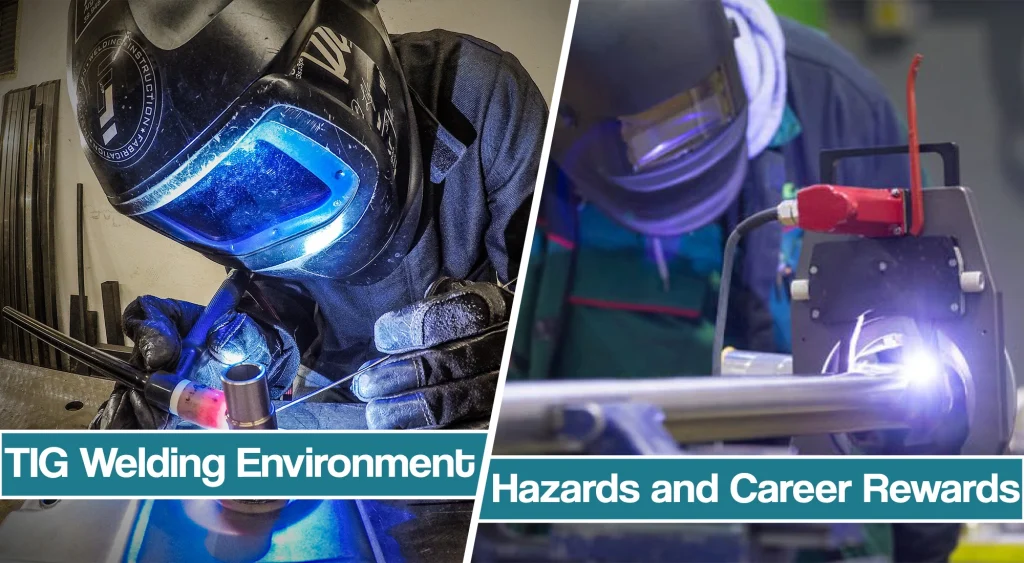
In this article, we’ll explore the unique challenges and rewards of a TIG career and take a closer look at the fascinating work environment of TIG welder in which they ply their trade.
Challenges Of TIG Welding
TIG welding, also known as Gas Tungsten Arc Welding (GTAW), is a specialized welding process that requires a high degree of skill, precision, and focus.
TIG welders use a non-consumable tungsten electrode to produce a weld on the workpiece, while a shielding gas protects the weld area from contamination. This process allows for greater control over the weld, resulting in clean, high-quality welds that are ideal for a range of applications.
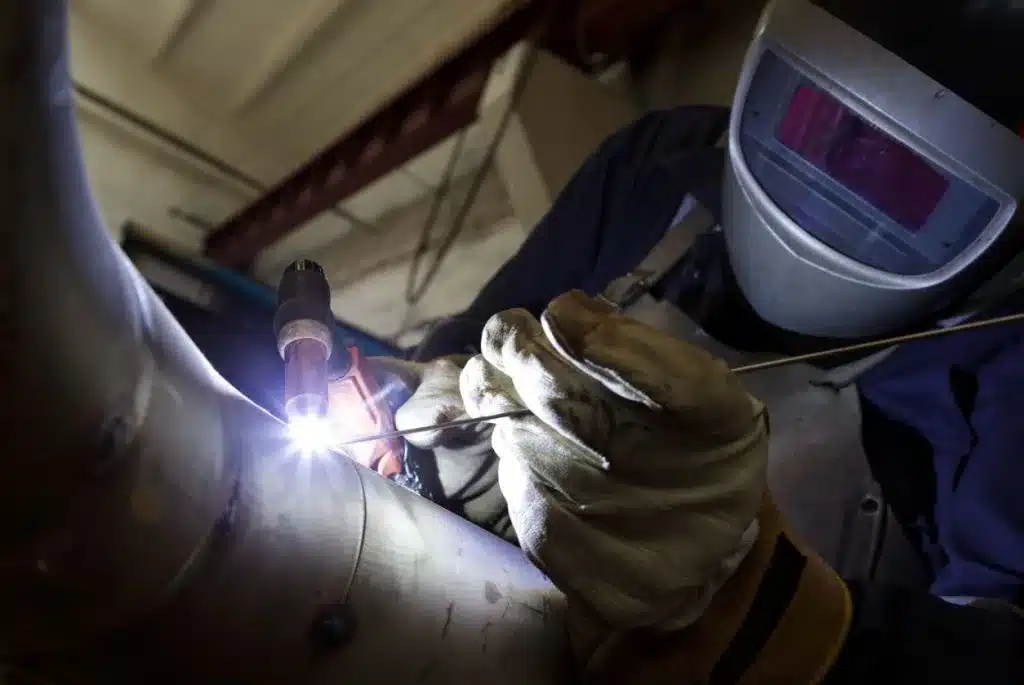
While working as a TIG welder can be a rewarding and fulfilling career, there are also a number of challenges that come with the job. Here are some of the key challenges and rewards of working as a TIG welder:
- Precision: TIG welding requires a high degree of precision and attention to detail. Even the slightest deviation from the ideal welding parameters can result in a weak or imperfect weld, which can compromise the quality of the finished product.
- Safety: Welding can be a hazardous occupation, with a risk of burns, eye damage, and respiratory issues from inhaling welding fumes. TIG welders must take strict precautions to protect themselves from these hazards, including wearing protective clothing, using ventilation systems, and following strict safety procedures.
- Physical Demands: TIG welding can be physically demanding, requiring welders to stand for long periods of time and maintain a steady hand for precise movements. This can be particularly challenging for welders who have pre-existing health conditions or disabilities.
Rewards of TIG Welding Career
Working as a TIG welder is a challenging but highly rewarding career that offers opportunities for artistic expression, high pay, and job satisfaction. While it requires a high degree of skill and attention to detail, those who are passionate about welding can find great fulfillment in this specialized field.
- High-Paying Career: TIG welding is a skilled trade that is in high demand in many industries, including aerospace, automotive, and construction. This demand has resulted in a high earning potential for experienced welders, with many earning six-figure salaries.
- Artistic Expression: TIG welding is often considered an art form, as it allows for greater control over the appearance and quality of the finished weld. This can be highly rewarding for welders who enjoy expressing their creativity through their work.
- Job Satisfaction: TIG welding can be a highly satisfying career for those who enjoy working with their hands and taking pride in their craftsmanship. Welders often have the satisfaction of seeing the products they create in use, which can be a rewarding experience.
Work Environment Of TIG Welder
The workplace environment of a TIG welder is a specialized area designed to minimize hazards associated with welding and promote safety and precision.
TIG welders work in a designated welding booth or welding station that is typically separated from other work areas to prevent sparks, fumes, and other welding hazards from affecting other workers. The welding booth or station is typically a confined space that is designed to be well-ventilated and well-lit to promote accuracy and safety.
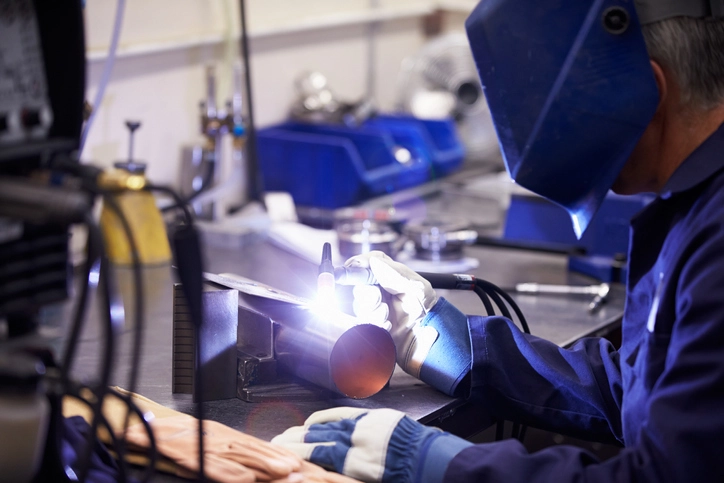
TIG welding requires the use of specialized equipment, such as a TIG welding machine, tungsten electrode, and welding torch, as well as other tools and equipment. The workbench or table where the TIG welder works should be set at a comfortable height to prevent strain and fatigue, and securely clamp the workpiece to prevent movement while welding. The welding booth or station should have adequate ventilation to remove harmful fumes and ensure clean air, as well as measures to protect against the noise generated by welding equipment, such as earplugs or earmuffs to protect hearing.
To ensure safety, TIG welders must wear protective gear, including a welding helmet, gloves, and protective clothing. The welding helmet must be equipped with a filter lens to protect the welder’s eyes from the bright light and harmful ultraviolet and infrared radiation generated by the welding process. Welding gloves protect the hands from heat and sharp metal, and the protective clothing protects the body from sparks and hot metal.
The work environment should also have measures in place to prevent accidents, such as clearly marked safety zones around the welding booth or station, and safety barriers or screens to protect other workers from the hazards of welding. The welding booth or station should also have an appropriate fire extinguisher within reach in case of emergency.
TIG Welding Outdoors – Workplace Environment
TIG welding outdoors can present additional challenges due to exposure to weather conditions and other outdoor hazards. In such environments, TIG welders must take extra precautions to ensure their safety and the quality of their work.
To TIG weld outdoors, the work area must be prepared, starting with a level and stable surface to prevent tripping and provide a stable base for the welding equipment.
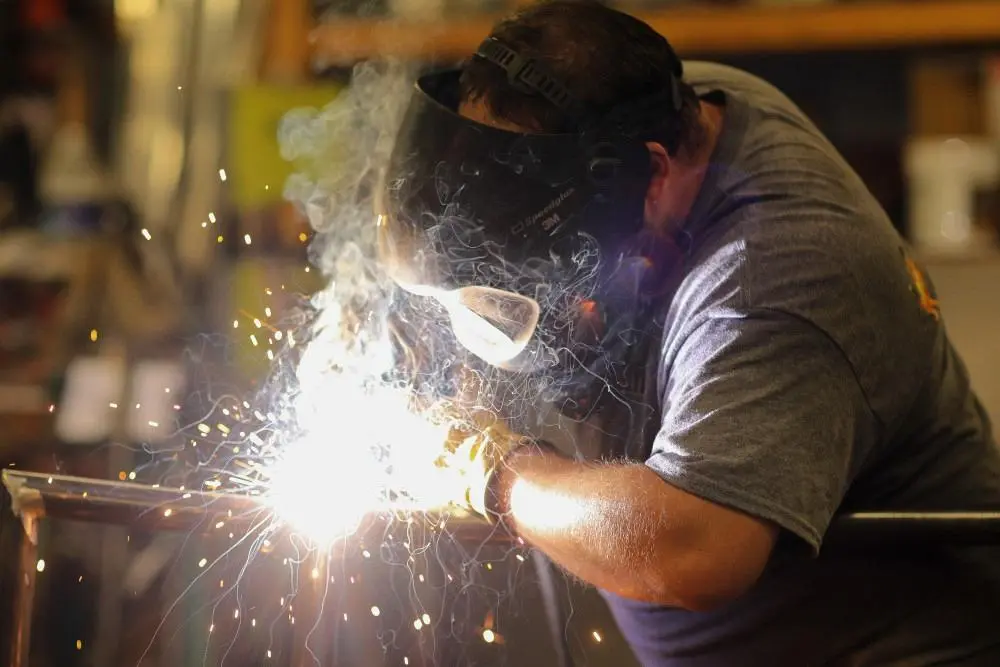
Depending on the weather conditions, the work area may need to be covered to protect against rain or snow, and to provide shade if working in direct sunlight. The work area should also be kept clean and free of any debris or flammable materials.
TIG welding outdoors requires specialized equipment, including a portable TIG welding machine and a generator to power it. The welder must also ensure that they have adequate extension cords and electrical outlets available to connect their equipment. Due to the presence of sunlight and other natural light sources, TIG welders should use a welding helmet with an auto-darkening lens that adjusts to changing light conditions, and be mindful of their line of sight to avoid looking directly at the sun.
One of the biggest challenges of TIG welding outdoors is wind. Wind can blow away shielding gas, making it more difficult to maintain a consistent welding arc, and can also blow away sparks, increasing the risk of fire. To counteract the effects of wind, TIG welders may need to use wind shields or create a makeshift wind barrier using materials such as tarps or plywood.
Hazards in TIG Welder’s Environment
The workplace of a TIG welder can be hazardous due to the nature of the work involved. TIG welding involves exposure to several hazards that can impact a welder’s health and safety. Some potential hazards in the workplace of a TIG welder include:
- Fumes and Gases: TIG welding produces fumes and gases that can be harmful to the respiratory system. Exposure to these fumes and gases can cause respiratory problems, such as bronchitis, lung cancer, and other respiratory illnesses.
- Ultraviolet Radiation: TIG welding produces intense ultraviolet (UV) radiation that can cause burns to the skin and eyes. Prolonged exposure to UV radiation can result in severe eye damage and even blindness. TIG welders must wear appropriate personal protective equipment (PPE) to protect their skin and eyes from UV radiation.
- Electrical Shock: TIG welding involves the use of high voltage electrical equipment, which can pose a risk of electrical shock to the welder. If a welder touches a live wire or a metal surface that is electrically charged, they can receive an electrical shock that can cause serious injury or even death.
- Noise: Welding equipment produces high levels of noise that can damage a welder’s hearing over time. Prolonged exposure to high levels of noise can lead to hearing loss and other hearing-related problems.
- Burns: TIG welding produces high levels of heat that can cause severe burns to the skin if the welder comes into contact with the hot metal or welding equipment.
- Repetitive Strain Injuries: TIG welding involves repetitive motions that can cause strain injuries, such as carpal tunnel syndrome, tendonitis, and other musculoskeletal disorders.
To minimize the risks associated with TIG welding, it is important to take appropriate safety measures. This includes wearing PPE such as welding helmets, gloves, and clothing, ensuring good ventilation in the work area, and following safe welding practices. TIG welders should also receive proper training on the equipment and processes involved in TIG welding, as well as be aware of the potential hazards and safety measures to minimize the risks.
Is TIG Welding Worth the Risk?
The decision to pursue a career as a TIG welder is a personal one and requires careful consideration of the potential risks and benefits of the job. While it is true that TIG welding involves exposure to hazards such as heat, bright light, fumes, and noise, there are many ways to mitigate these risks with proper training, equipment, and protective measures.
TIG welding is a skilled trade that is in high demand in many industries, including aerospace, automotive, and construction.
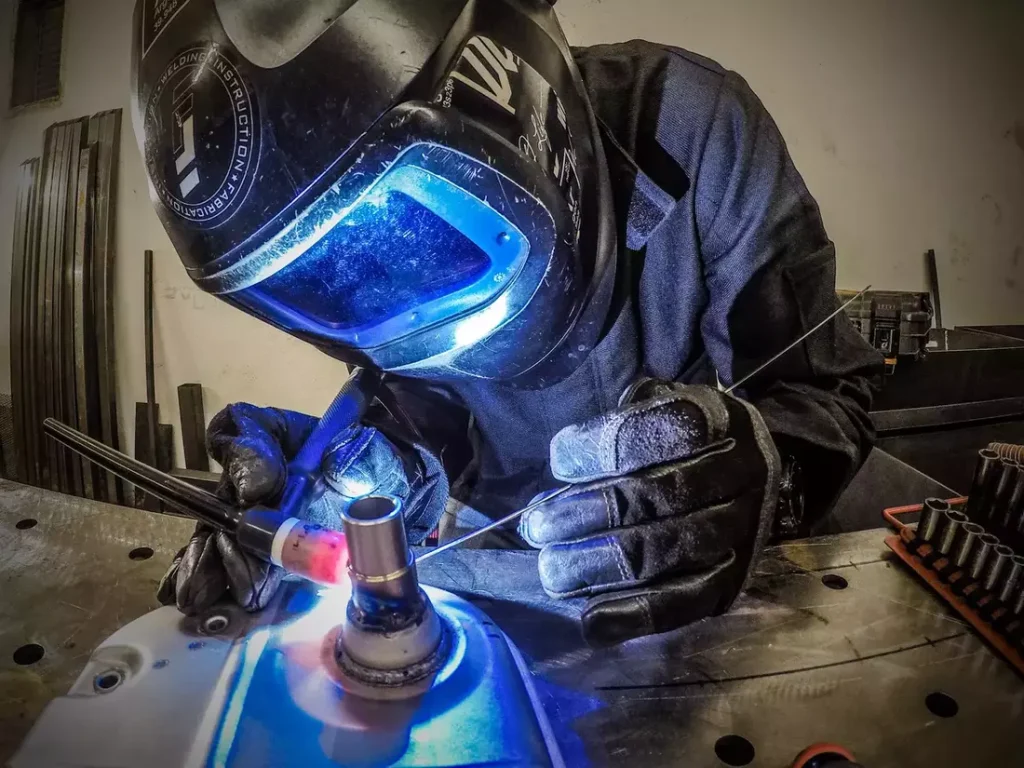
This demand has resulted in a high earning potential for experienced welders, with many earning six-figure salaries. Additionally, TIG welding offers opportunities for artistic expression, as well as the satisfaction of seeing the products created in use.
Despite the potential hazards, TIG welding can be a safe and fulfilling career with the proper training and equipment. Employers are responsible for providing their employees with the necessary training and equipment to perform their jobs safely. TIG welders must also wear protective gear, including a welding helmet, gloves, and protective clothing to minimize the risks associated with exposure to heat, bright light, and fumes. Proper ventilation and lighting in the work environment can also help to reduce exposure to hazards.
Conclusion
The work environment of a TIG welder is a specialized area that prioritizes safety and precision to produce high-quality welds that meet industry standards. TIG welders work in a designated welding booth or welding station that is separated from other work areas to prevent hazards associated with welding from affecting other workers. The work environment is well-ventilated, well-lit, and designed to minimize hazards associated with welding, while protective gear such as welding helmets, gloves, and clothing ensure the safety of the welder.
Although there are potential hazards associated with TIG welding, proper safety measures and training can mitigate these risks. The rewards of a TIG welding career can be significant, including the satisfaction of creating precise and high-quality welds, as well as the potential for career advancement and earning a good salary.
Resources:
- https://www.millerwelds.com/resources/article-library/tig-it-how-a-tig-welder-works-and-when-to-tig-weld
- https://ptt.edu/blog/how-is-the-working-environment-of-a-welder/
- https://www.careereducationadvisor.com/Welder-Career-Working-Environment.htm
- https://www.bls.gov/ooh/production/welders-cutters-solderers-and-brazers.htm
- https://www.millerwelds.com/resources/article-library/5-tips-on-how-to-create-a-work-environment-that-attracts-the-best-new-welders




